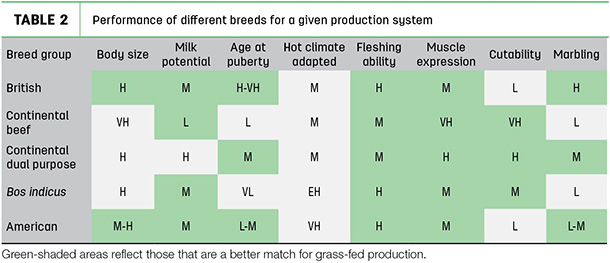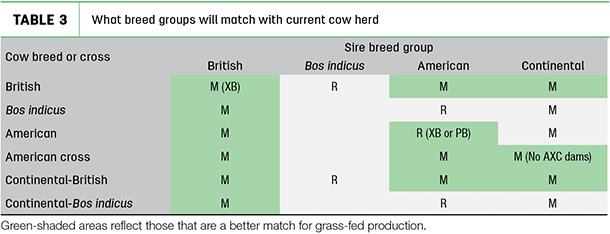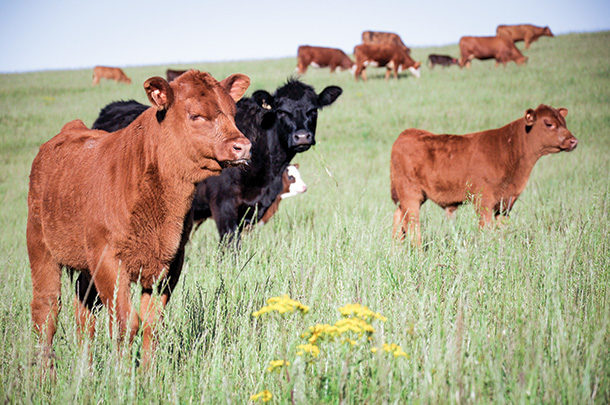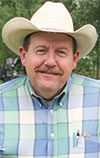Any breed can be used to produce grass-fed beef. Some breeds are more suitable than others depending on several considerations, both economic and environmental.
Production can be centered around a cow herd specifically selected for grass-fed production, or it might entail purchase of feeder animals from others to simply “run” on grass for finishing. All these can be affected by the genetics or selection of the breeds or classes of animals chosen.
Table 1 was developed by Dr. Gordon E. Dickerson in the 1970s, and it highlights the first issue in grass-fed beef production: forage availability (quantity as well as quality) and how it should affect genetic decisions affecting other traits.

Across the top, on the left-hand side are two production constraints: forage availability and environmental stress. In most grass-fed production systems, forage availability should be at least medium (Med), although at times it might be high or low. Environmental stress in a grazing program is generally high since cattle are raised outside in hot and cold as well as dry and wet environments.
Putting those together (highlighted in green) and reading across Table 1, one can see that an efficient cow herd needs low to medium milk production; medium mature size; high ability to store energy, tolerate stress and calving ease; and a low to medium lean-to-fat ratio (in line with the ability to retain fat or energy). If forage availability is high (or low) in the cattle operation, then you will be able to select for different levels of production.
Breeds of cattle have different levels of performance for different traits. There is some overlap, but breeds are generally noted for their superiority in a few (or several) specific traits. Table 2 is compiled from research published at the USDA Meat Animal Research Center and other breed comparisons at different land-grant universities.

The first column lists breed groups rather than breeds based on geographic origin and purpose. All are beef breeds (some were dual purpose originally) and all have changed since this ranking was first developed in the 1980s. The British breed group included Angus, Hereford and Red Angus; continental beef included Charolais and Limousin; continental dual purpose (indicating higher milk production) included Braunvieh, Gelbvieh and Simmental; Bos indicus included Brahman; and American included any of the established breeds created from Brahman and British or continental breed groups (Beefmaster, Braford, Brangus, Red Brangus, Santa Gertrudis and Simbrah).
Table 2 lists eight production traits: body size (mature size), milk potential (milking ability), age at puberty (H means youngest and VL means oldest), hot climate adapted (stress tolerance), fleshing ability (ability to store energy), muscle expression, cutability (lean-to-fat ratio) and marbling.
The purpose of Table 2 was to evaluate the relative level of performance of different breeds or groups of breeds, either as straightbreds or as crosses, for a given production system. Table 2 matches breed group, and ultimately breed and individuals within the breed, to the level of production recommended in Table 1 based on forage availability and environmental stress.
When this is done, one can see that many breeds have acceptable attributes for grass-fed beef production as long as performance potential does not exceed production conditions.
Many of these breed groups can be used profitability as straightbreds or in crossbreeding. There is hybrid vigor for growth and for carcass merit when used as crosses. If crossbred cows are used either commercially or as a breed (one of the American breeds, for example), the value of hybrid vigor is greatest for adaptability, longevity, reproduction and maternal ability. However, there are advantages and disadvantages of specific crosses, even for grass-fed beef production.
Table 3 lists possible sire breed groups across the top and possible dam breed groups along the left column. The cow breed or cross listed down the left-hand column reflect most of the types in U.S. herds.

Producers can determine which sire breed group will match best with their current cow herd. Most of the boxes have an M or an R indicating whether this particular cross of sire group and cow breed will produce a market-acceptable calf, an acceptable replacement heifer or both.
In some cases, there is an XB or PB in the box as well, which means the calf can be crossbred (British or American) or purebred (American). The comment “no AxC dams” indicates that American-on-continental (both beef and dual purpose types, which are combined in Table 3) crosses should not be used as they can get too large, mature too late and have higher requirements.
If a producer wants to see how their calves might fit a grass-fed program, they can look at the type of sires and dams used and see if they fit in the green-shaded areas of Table 3.
From Table 3, it can be seen that the use of the British sire breed group places more calves from a wider variety of dams in an acceptable grass-fed position. However, there are also many crosses in the American and continental sire breed groups that will also work as long as mature size remains medium and the amount of Bos indicus remains less than 50%.
Consideration of breeds and breeding systems are only part of genetic selection. Once breeding objectives are determined, resources known, and the sire and dam breeds or crosses are selected, then selection of individuals for the level of performance desired – using expected progeny differences (EPDs) or, even better, a selection index – needs to begin.
In general, moderate growth, muscle and milk are desirable with the ability to store some fat and tolerate stress for grass-fed beef production.
Selection from the middle rather than extremes is more desirable, and use of breed-selection general purpose indexes rather than carcass or maternal indexes may be more effective in reaching selection goals for grass-fed beef production.









